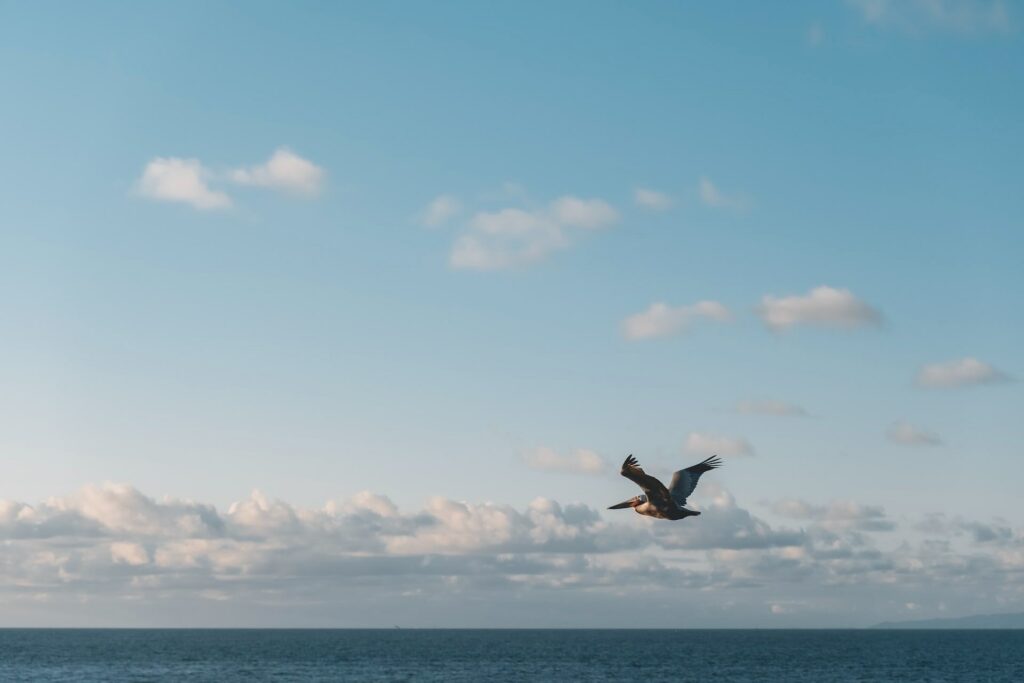En vedette dans cet article
San Diego, Californie
Aventure d'observation des baleines et des dauphins à San Diego
En savoir plus
Continuez à explorer
San Diego, Californie
Essential San Diego
En savoir plus
You can see some amazing seabirds on our City Cruises Whale Watch cruise in San Diego, the most common of which can be found here. Here are some other, less common seabirds, including several species of herons, that can be found in San Diego Bay.
Reddish egret (Egretta rufescens)
The reddish egret is a fairly large heron with a gray body, a reddish neck, and bluish-black gray legs. Its bill is mostly pink and tipped with black. This active egret searches for food in shallow, saltwater habitats and often runs and hops to catch fish with its wings spread out. San Diego is near the northern part of the range for this species on the Pacific Coast.
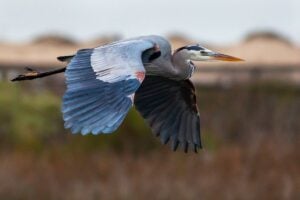
Little blue heron (Egretta caerulea)
The little blue heron is a small heron with a dark bluish-gray body and a purple to dark reddish head and neck. Juveniles are mostly white with light gray wing feathers. When hunting fishes and frogs in shallow freshwater or saltwater habitats, the little blue heron will stand still in shallow water and wait for potential prey to swim nearby.
Tri-colored heron (Egretta tricolor)
This medium-sized heron is mostly dark gray with a white belly and reddish feathers on its neck and back. The juvenile has a white line running down its throat. When foraging, it either stands and waits for fish to swim by, or walks to stir up the bottom with a foot to startle prey.
Green heron (Butorides virescens)
This small, beautifully-colored heron typically rests in a crouched position at the water’s edge often hidden within vegetation. It has a greenish back with a chestnut neck, face, and chest, white streaks on each cheek and throat, dark gray wings, a gray and yellow bill, and yellow legs. The green heron usually sits at the water’s edge and waits for fish and frogs to move by, then spears them with its dagger-like bill.
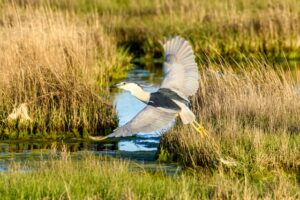
Black-crowned night heron (Nycticorax nycticorax)
The black-crowned night heron is fairly stocky with relatively short yellow legs. The plumage is dark gray from the top of its head to the back, with light-gray wing feathers, and white from the face to the belly. It also has a white patch extending from the base of the upper bill to above the red eyes. Juveniles are mottled brown and white. As its name implies, the black-crowned night heron feeds from dusk until dawn, searching for insects, worms, fishes, amphibians, and other small land and aquatic animals.
Brandt’s cormorant (Phalacrocorax penicillatus)
The Brandt’s cormorant is an iridescent black seabird found in saltwater habitats along the Pacific Coast of North America. Adults have a pale patch at the base of the throat, a bright blue throat pouch, and fine, white plume feathers on their head, neck, and back during the nesting season. During the non-breeding season, adults are much duller in color while juveniles are also a much duller brownish-black. Cormorants swim at the surface and then dive to catch fish or squid, using their webbed feet to actively swim after prey. Like other cormorants, the Brandt’s cormorant holds its wings out to dry after diving.
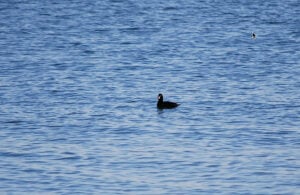
Surf scoter (Melanitta perspicillata)
This sea duck is strikingly patterned in black-and-white. The male is all black with a white forehead patch and a white patch on the back of his neck, and a white, orange, and black patterned bill. The female is a lighter brownish-black with white patches on each side of the head and at the base of the mostly dark gray bill. Nesting takes place during summer in freshwater lakes in high-elevation forests and the tundra mainly in Alaska and Canada. Surf scoters can be found in winter along both coasts of North America where it can often be seen diving for mollusks, crustaceans, and other aquatic invertebrates.
Pacific brant (Branta bernicla)
This small sea goose has a black head, neck, and chest with a broken white “collar” in the upper neck region, a brownish back, a black to light gray belly, and a white rump. The Brant nests in the Arctic on the tundra and spends winters feeding on eelgrass, sea lettuce, and other aquatic plants along both coasts of North America. The Pacific subspecies of brant winters from British Columbia to Baja California, Mexico, and can often be seen swimming and feeding in flocks during the late fall to early spring months in San Diego Bay.
Western grebe (Aechmophorus occidentalis)
The western grebe is a black and white grebe with a long neck, a spear-like yellow bill, and red eyes. This species has a black back with black extending along the back of its neck and a black cap that extends below the eyes. The almost identical Clark’s grebe can be distinguished from the western grebe by its white face (its black cap does not extend below the eyes). Western grebes nest on freshwater lakes and marshes and overwinter in bays, estuaries, and sheltered coasts. They dive to catch fish and occasionally crustaceans and aquatic worms. In the summer nesting grounds, adults perform an elaborate courtship display by rushing across the water with their necks extended.
Pied-billed grebe (Podilymbus podiceps)
The pied-billed grebe is a small, stocky, brown, bird with a short wedge-shaped bill, a brown body, and an extremely short tail. Their bill is marked with a vertical black stripe in the summer giving rise to their common name. Pied-billed grebes dive to hunt small fishes, crustaceans, insects, amphibians, and other small aquatic animals in freshwater lakes, rivers, marshes, and saltwater estuaries and bays.
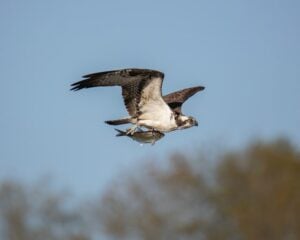
Osprey (Pandion haliaetus)
The Osprey is a common fish-eating hawk spotted in freshwater and saltwater habitats worldwide except in Antarctica. These attractive birds of prey are black to brown and white and have hooked bills and yellow eyes. They have a reversible outer toe on each foot and barbed pads on the soles that let them catch and easily grasp slippery fish. Osprey pairs build huge nests of sticks and other vegetation that are added to each nesting season and used from year to year. Often these nests are built on sea stacks, dried tree snags, and even man-made structures such as light towers, utility poles, and artificial platforms. Some of these nests are decades old and can be 10 to 13 feet tall and 3 to 6 feet across.
Pélican brun(Pelecanus occidentalis)
Le pélican brun est le plus grand pélican d'Amérique du Nord. Ces grands oiseaux ont une apparence bossue caractéristique, un long cou et un grand bec avec une poche de gorge utilisée pour ramasser les poissons. Les pélicans sont principalement de couleur brun foncé, avec un peu de brun grisâtre plus clair sur les ailes et le cou. On les trouve dans les zones côtières de la majeure partie de l'Amérique du Nord, où ils se nourrissent presque exclusivement de petits poissons qu'ils capturent en plongeant dans l'eau depuis les airs. La reproduction a lieu le long des côtes, de la Virginie au Texas et à la Californie, et à l'intérieur des terres, le long des Grands Lacs.
Pélican blanc d'Amérique(Pelecanus erythrorhynchos)
The American white pelican is one of the largest North American birds, with a wingspan reaching almost 10 feet. They are all white with black wingtips and have a long bill with a large throat pouch used for scooping up fish. Pelicans feed cooperatively, swimming in groups to herd and trap small fishes in shallow water where they can be easily caught. These big birds breed along inland lakes in western Canada and the northern United States and spend winters along coasts from California to Texas.
Cormoran pélagique(Phalacrocorax pelagicus)
Le cormoran pélagique est une espèce de cormoran qui se reproduit dans les régions océaniques ouvertes du monde entier. Cet oiseau est entièrement noir, avec un long bec crochu et des pattes palmées. Le cormoran pélagique est un excellent nageur et peut plonger à des profondeurs de plus de 150 pieds à la recherche de poissons. Ces oiseaux nichent généralement sur les parois des falaises ou dans les arbres près des plans d'eau. Le cormoran pélagique est une créature sociale et forme souvent de grandes colonies avec d'autres oiseaux. Cependant, cette espèce n'est pas sans prédateurs ; les goélands, les aigles et d'autres oiseaux de proie s'en prennent souvent aux cormorans pélagiques.

Cormoran à aigrettes(Phalacrocorax auritus)
Le cormoran à aigrettes est un grand oiseau d'eau au long cou et au bec crochu. On le trouve dans des habitats d'eau douce et d'eau salée dans une grande partie de l'Amérique du Nord. Le cormoran à aigrettes est un excellent nageur et plongeur et se nourrit de poissons, d'écrevisses et d'autres animaux aquatiques. Le plumage foncé de l'oiseau l'aide à se camoufler des prédateurs, et ses pattes palmées lui permettent de pagayer rapidement dans l'eau. Le cormoran à aigrettes est une espèce protégée, et son nombre a augmenté ces dernières années. Cependant, l'habitude de l'oiseau de nicher sur des structures artificielles, comme les lignes électriques et les bateaux, a provoqué quelques conflits avec les humains.
Pigeon biset(Columba livia)
Le pigeon biset est une espèce de pigeon originaire d'Europe, d'Asie et d'Afrique. C'est aussi l'oiseau le plus commun dans les villes. Le pigeon biset est un oiseau de taille moyenne, au corps dodu et aux pattes courtes. Son plumage est généralement gris ou bleu, mais il peut aussi être blanc, brun ou noir. L'oiseau a une petite tête avec un bec pointu. Les pigeons bisets vivent généralement en bandes et on les voit souvent chercher de la nourriture dans les zones urbaines. Ils sont également connus pour leurs vocalises roucoulantes. Le pigeon biset est une espèce importante à la fois dans la nature et en captivité. Il est souvent utilisé dans la recherche en raison de sa capacité à s'adapter à différents environnements. Le pigeon biset a également été introduit dans de nombreuses régions du monde, où il est devenu une espèce nuisible.
Conclusion
Si vous souhaitez voir certains des oiseaux de mer les moins courants de la baie de San Diego, consultez notre liste. Bien que de nombreuses autres espèces puissent être observées ici, nous pensons que ces quinze espèces vous donneront un bon aperçu de ce qui existe. Avez-vous repéré l'un de ces oiseaux lors de vos sorties dans la baie ? Faites-nous en part dans les commentaires ci-dessous !
FAQs – San Diego Sea Birds
What birds are on the beach in San Diego?
Common sightings on San Diego beaches include Brown Pelicans, Ospreys, various species of Ducks and Grebes, Cormorants, Herons, Seagulls, and Egrets. These birds are drawn to the coastal and safe haven watershed climates San Diego offers, making the area a rest stop for migratory birds annually.
What kind of seagulls are in San Diego?
San Diego is home to several types of seagulls, including the California Gull, Western Gull, Ring-billed Gull, and the Heermann’s Gull. These seagulls are known for their adaptability and opportunistic feeding habits.
Are there Osprey in San Diego?
Yes, Ospreys, also known as Sea Eagles, Fish Hawks, or Sea Hawks, are present in San Diego. These predatory raptors are identifiable by their black eye patch and brown and grey body coloring. For example, you can go see them off Harbor Drive!
What is the Black seabird in San Diego?
The Black seabird commonly seen in San Diego could be the Brandt’s Cormorant, among other cormorant species like the Pelagic and Double-Crested Cormorant. The Brandt’s Cormorant is most commonly seen, especially around La Jolla and Point Loma.
What is the brown sea bird in San Diego?
The Brown Pelican is a prominent brown sea bird in San Diego. It’s recognizable for its long beak with a gular sack and is often seen flying in ‘V’ formation along the coastline.
What are the birds at La Jolla Shores?
At La Jolla Shores, you’re likely to see a variety of seabirds including Brown Pelicans, Cormorants, and different species of Gulls and Terns. The area provides a rich habitat for these birds, especially during the nesting season.
En vedette dans cet article
San Diego, Californie
Aventure d'observation des baleines et des dauphins à San Diego
En savoir plus
Continuez à explorer
San Diego, Californie
Essential San Diego
En savoir plus


